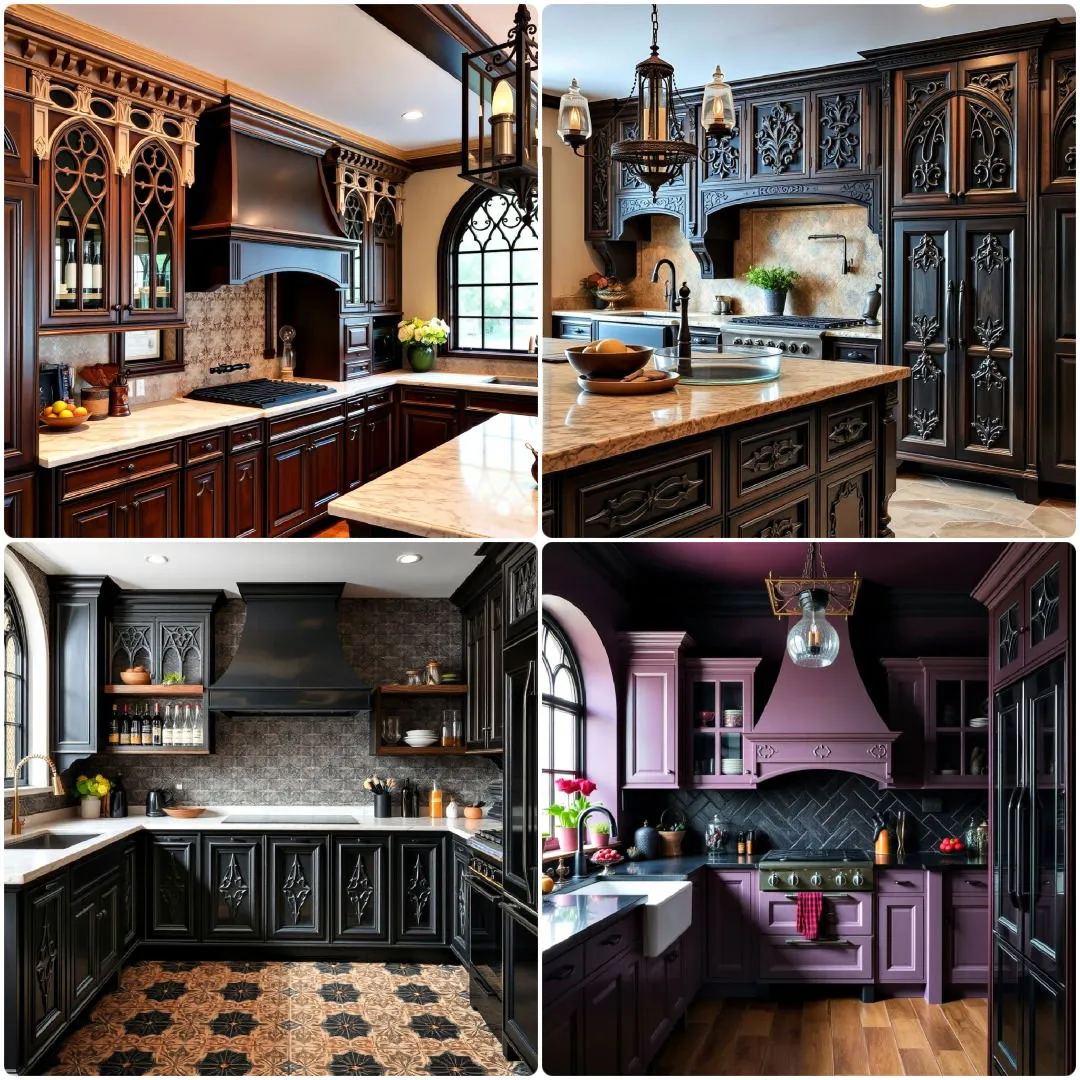What is Gothic Kitchen Decor
Gothic kitchen decor is an alluring aesthetic that brings the drama and mystique of the Gothic era into the heart of your home. It’s a style that embraces the dark, the ornate, and the historical, creating spaces that are both elegant and evocative. Unlike the minimalist or overly bright styles, gothic kitchens revel in rich colors, intricate details, and a sense of timelessness. It’s about crafting a space that feels both luxurious and a little bit mysterious, a place where you can escape the everyday and immerse yourself in a world of dark beauty. It’s a design choice that speaks to those who appreciate history, artistry, and a touch of the unconventional.
The Defining Elements of Gothic Style
Several key elements define gothic style, forming the foundation for any gothic-inspired space, including the kitchen. Understanding these elements is essential when you start planning your gothic kitchen. The core elements include a specific color palette, ornate details, and architectural features. A good gothic kitchen design should always incorporate these features to achieve an authentic and captivating look. Each element plays a critical role in creating the atmosphere and overall feel of the space, from the initial color scheme to the selection of decorative elements.
Dark Color Palette
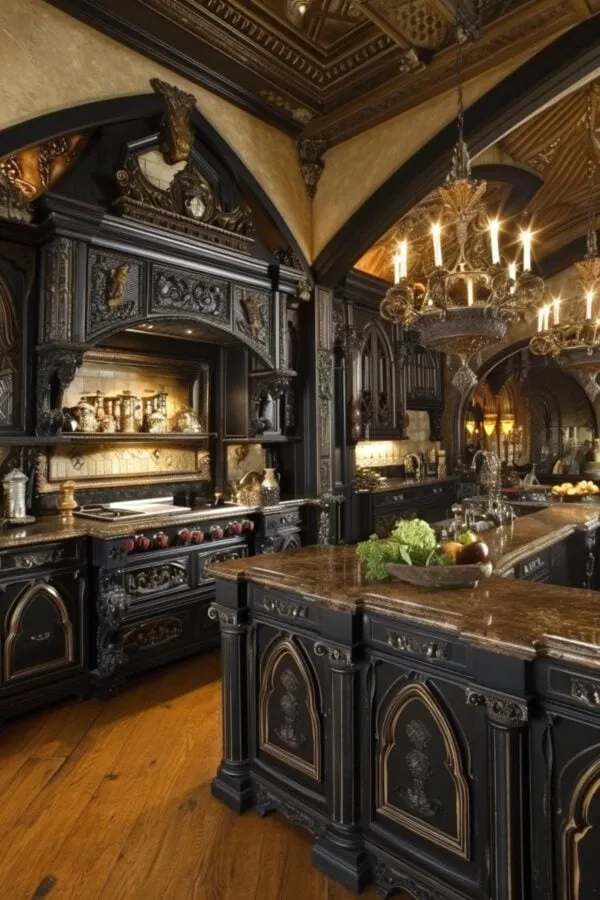
The hallmark of gothic style is its embrace of a dark and dramatic color palette. Think deep blacks, rich burgundies, dark emerald greens, and mysterious purples. These colors set the tone, creating an atmosphere of luxury and intrigue. While these deeper shades are primary, you can incorporate metallic accents like gold, silver, or bronze to add shimmer and reflect the available light. The balance is key. Ensure you use these colors to create a cohesive visual experience, avoiding clashes and working towards a dramatic yet refined aesthetic.
Ornate Details
Ornate details are another cornerstone of gothic design. This includes intricate carvings, elaborate moldings, and decorative hardware. Think about adding details with arched doorways, pointed arches, and gothic-inspired furniture with detailed legs and backs. The goal is to incorporate elements that evoke a sense of history and craftsmanship, adding visual interest and depth. These elements will instantly make your kitchen feel more elegant and characterful.
Architectural Elements
Architectural elements like pointed arches, vaulted ceilings, and stone or brick accents are essential for achieving an authentic gothic look. If you’re renovating, consider incorporating these features into your design. If you’re working with a smaller budget, you can achieve a similar effect by adding faux stone panels, architectural moldings, or even strategic placement of mirrors to mimic the feel of these features. The right architectural details will transform your kitchen from a functional space into a work of art.
Choosing Your Gothic Kitchen Style

When planning your gothic kitchen, you have a few options regarding the style that you can choose. The choice of which style to choose really depends on your personal preferences. You could embrace the traditional gothic look, or lean towards a more modern take on the style. You can also add your own personal touches to give the space your own unique twist. The key is to find a style that resonates with you and complements the rest of your home. Here are a few of the main style options.
Modern Gothic
Modern Gothic combines the drama of gothic design with contemporary elements. This style often features a darker color palette but with a cleaner, more streamlined approach. This means less ornate details and more emphasis on sleek lines and minimalist hardware. This style is perfect for those who want to create a sophisticated and elegant kitchen without overwhelming their space with too much detail. The result is a balanced and stylish space that feels both contemporary and gothic-inspired. Consider mixing dark cabinets with stainless steel appliances or adding a modern chandelier to enhance the overall look.
Traditional Gothic
Traditional Gothic embraces the historical roots of the style, incorporating elaborate details and a sense of grandeur. This style often uses heavy, dark wood, intricate carvings, and ornate hardware. Consider using dark wood cabinets, and adding gothic-inspired lighting fixtures. This is the perfect style for those who want to create a truly immersive and historically rich kitchen. You can enhance this look by adding vintage furniture, tapestries, and decorative accessories that capture the essence of the Gothic period.
Adding Gothic Decor Elements
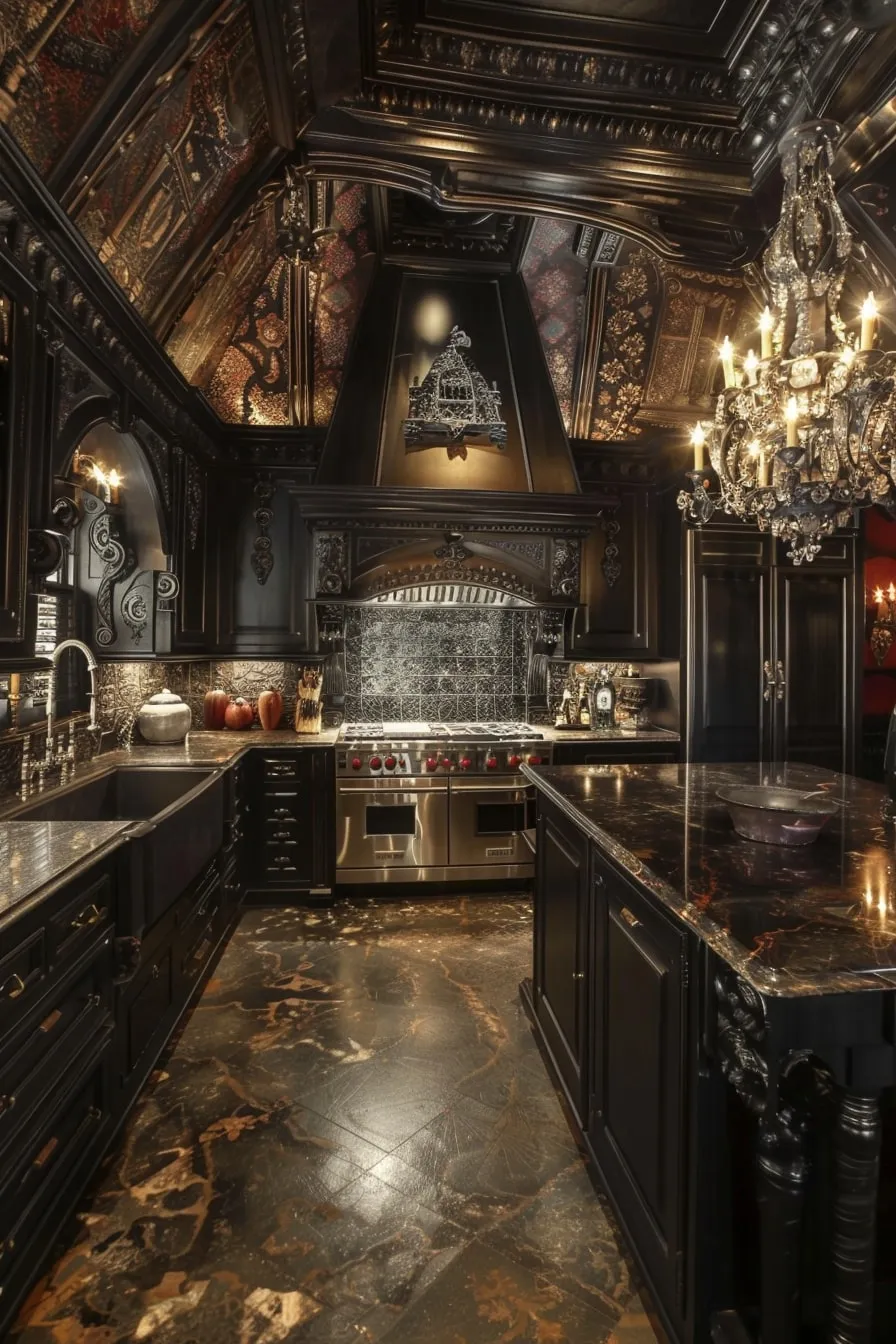
Once you have the fundamental architectural and design elements in place, it’s time to focus on the decor. The choice of furniture, lighting, textiles, and accessories is what brings the space together. These elements add character and personality, and they can highlight the aesthetic of your gothic kitchen. Consider the style and design to ensure all the elements work together. Pay attention to the small details, such as the style of the hardware on your cabinets, the materials used for your countertops, and the lighting fixtures you choose. These design choices will define your space.
Furniture Selection
Select furniture pieces that fit the gothic aesthetic. Look for pieces with dark finishes, intricate carvings, and elegant lines. Consider a dining table made of dark wood with detailed legs and a matching set of chairs. For additional seating, you might want to add a velvet-upholstered bench or a set of gothic-style bar stools. Antique or vintage furniture can add authenticity, but modern pieces with gothic-inspired design elements can also work well. Avoid anything too modern or minimalist; the key is to choose items that evoke a sense of history and drama. When choosing your pieces, always take into consideration the overall size and layout of your kitchen.
Lighting and Ambiance
Lighting is vital in gothic kitchen decor. Choose lighting fixtures that complement the dark color palette and enhance the atmosphere. Consider using chandeliers with ornate details, wrought-iron sconces, or pendant lights with a gothic flair. Candlelight can also play a significant role. Place candles on your dining table, countertops, and shelves to create a warm and inviting ambiance. Dimmer switches are essential to control the lighting intensity and create the perfect mood. Avoid overly bright or harsh lighting; the goal is to create a space that feels both luxurious and mysterious.
Textiles and Fabrics
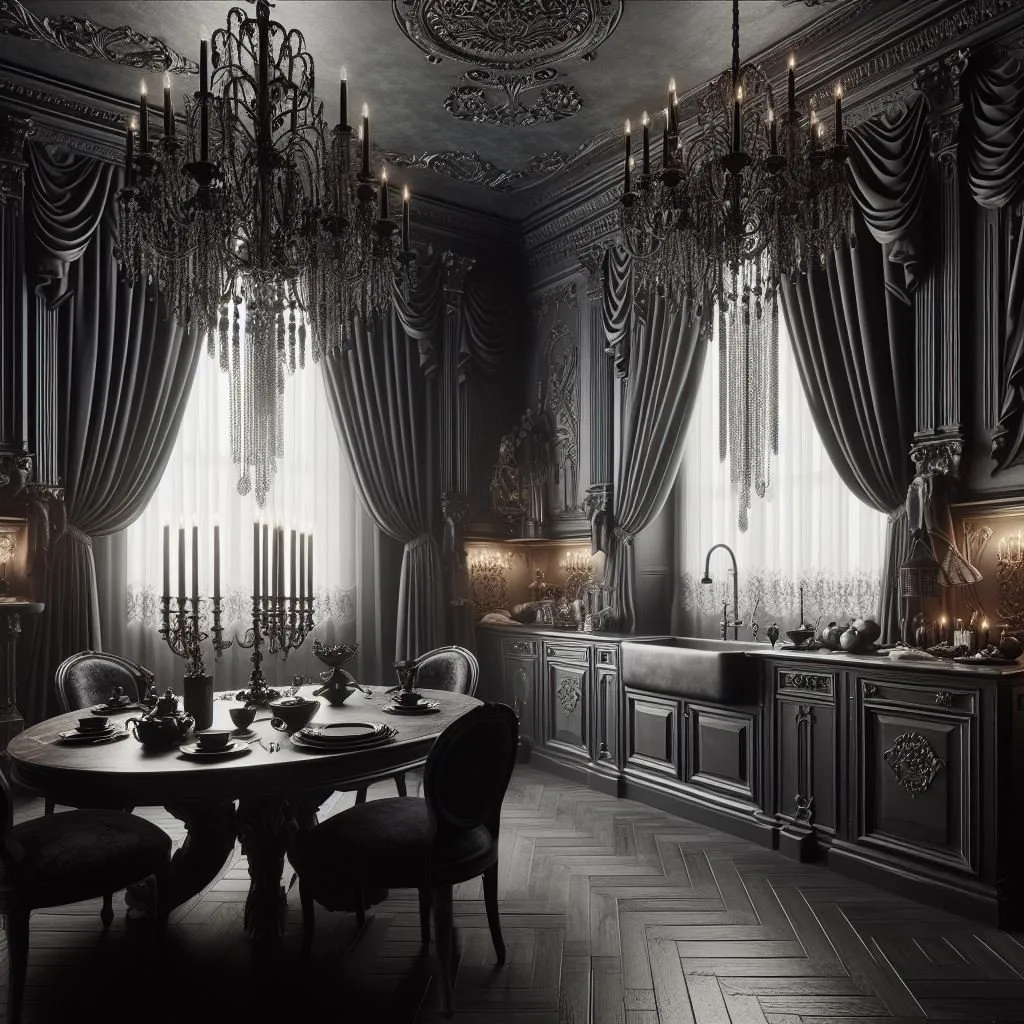
Textiles can add texture, depth, and softness to your gothic kitchen. Use velvet curtains or drapes in rich, dark colors to soften the space and enhance the overall ambiance. Add velvet cushions to your dining chairs or a tapestry to one of your walls. These fabrics will add a layer of luxury and visual interest. Be mindful of the texture and pattern of your textiles. Look for fabrics with intricate patterns or rich textures. Consider the overall color scheme and ensure that your textiles complement the other elements in the kitchen.
Gothic Kitchen Decor Must-Have Accessories
Accessories are the finishing touches that bring your gothic kitchen to life. The right accessories add character and personality. When choosing your accessories, look for pieces that complement the style and the aesthetic. The goal is to choose accessories that add interest. Consider the style and design to ensure that all the elements work together to highlight the aesthetic of your gothic kitchen. Pay attention to the small details to ensure that your kitchen reflects your own sense of style.
Wall Decor
Wall decor is a great way to add character and personality to your gothic kitchen. Consider hanging gothic-inspired artwork, such as portraits, landscapes, or abstract pieces with dark, dramatic themes. Mirrors with ornate frames are a classic addition, as they can reflect light and create an illusion of space. Tapestries or fabric wall hangings can also add texture and depth. Select pieces that complement the overall aesthetic of the space, and consider using a gallery wall to create a unique visual statement. Remember to choose pieces that are not only aesthetically pleasing but also durable and easy to maintain in a kitchen environment.
Tableware and Utensils
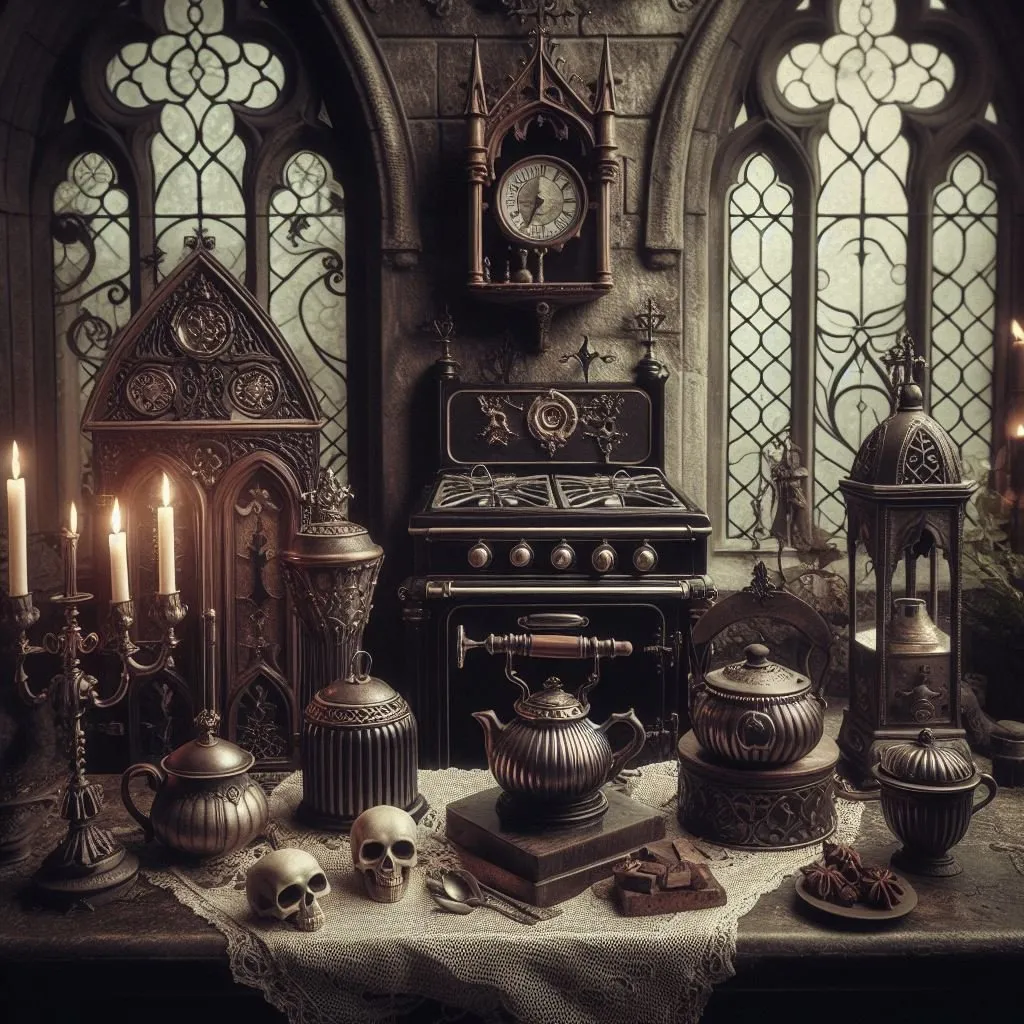
Tableware and utensils can enhance your gothic kitchen decor. Choose dark-colored or metallic tableware to complement the overall aesthetic. Consider using black or deep burgundy plates, bowls, and cups. Crystal glassware and silverware with ornate handles add a touch of luxury. Decorative serving dishes and trays can also be used. When setting your table, consider using a dark tablecloth, candles, and elegant centerpieces to create a dramatic and inviting atmosphere. These details will enhance your dining experience and reflect your unique sense of style.
Finding Inspiration and Resources
Finding inspiration and resources is crucial when embarking on a gothic kitchen decor project. There are many avenues to consider that provide you with endless ideas. Take advantage of these resources to make sure that your space reflects your personality and style. By actively seeking out resources and ideas, you can make your gothic kitchen a reality. Here are the best resources for inspiration and ideas.
Websites and Blogs
Many websites and blogs are dedicated to interior design, including gothic kitchen decor. These sites offer inspiration, tutorials, and product recommendations. Some great websites offer extensive guides, design ideas, and shopping tips to help you get started. You can also find articles on how to incorporate specific gothic elements into your kitchen design, such as dark color palettes, ornate details, and architectural elements. Make sure you check out design blogs for expert advice, step-by-step guides, and style insights. You can also find examples of completed gothic kitchen projects to help you envision what your own space could look like.
Social Media Platforms
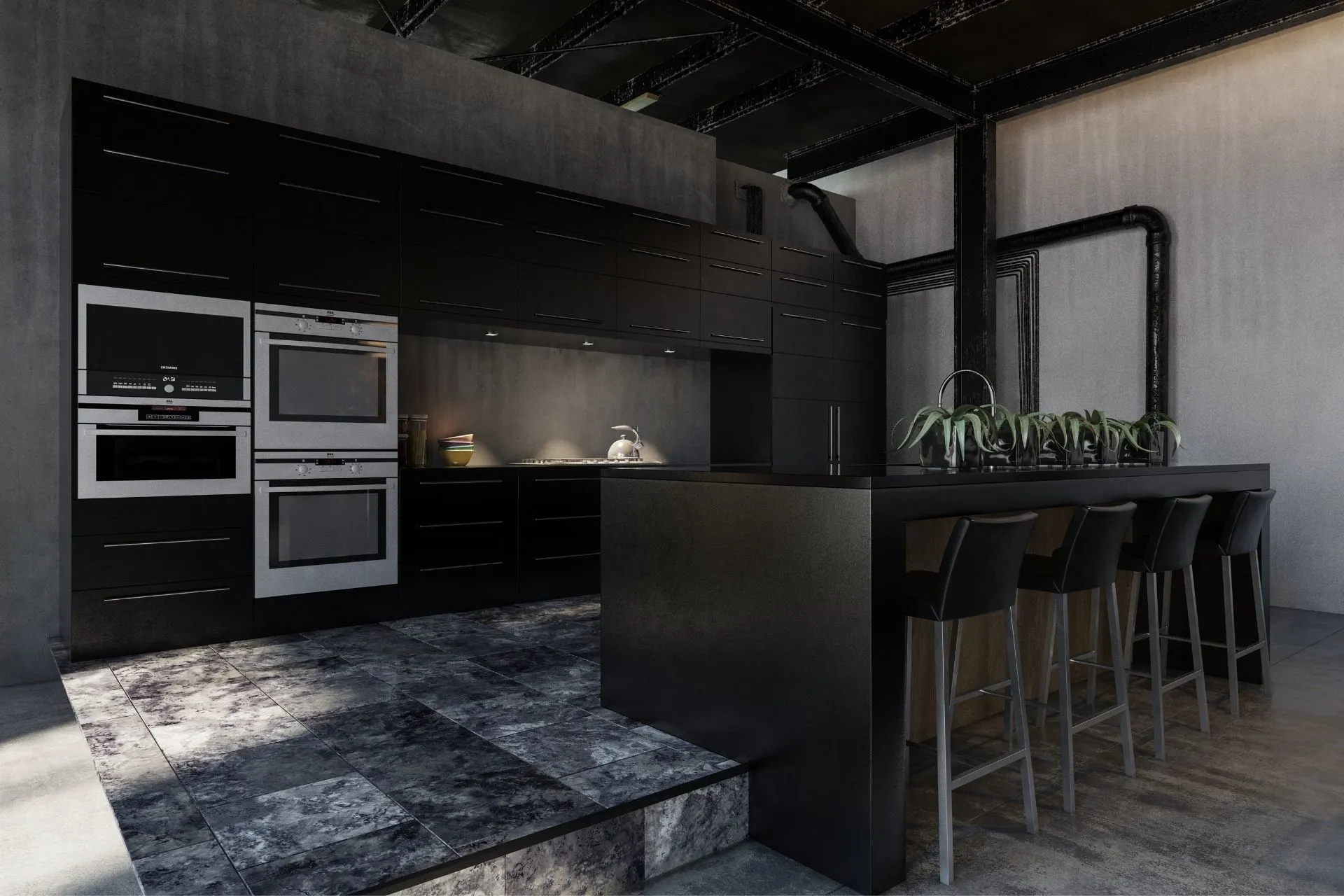
Social media platforms like Pinterest and Instagram are excellent sources of inspiration. Search for gothic kitchen decor to find images of completed projects. Use these visuals to collect ideas and create mood boards for your project. Consider exploring hashtags such as #gothickitchen, #darkinteriors, and #gothicdecor to discover design ideas, DIY projects, and shopping recommendations. These platforms allow you to connect with other enthusiasts, exchange ideas, and learn about new products and trends. Follow interior designers and home decor enthusiasts for daily inspiration and updates.
DIY Projects and Tutorials
DIY projects and tutorials are great resources for gothic kitchen decor. Numerous online resources offer step-by-step guides for creating gothic-inspired decor elements, such as painting cabinets in a dark color, adding decorative moldings, or creating unique accessories. Explore DIY blogs and video tutorials for step-by-step instructions and tips. You can also find ideas for repurposing old items to add a touch of gothic style to your space. DIY projects offer a cost-effective way to achieve the desired look, allowing you to add a personal touch to your space. Consider creating custom artwork, upcycling old furniture, or making your own decorative accents.
Maintaining Your Gothic Kitchen
Maintaining a gothic kitchen requires some care to keep it looking its best. Dark colors can show dust and fingerprints, so regular cleaning is essential. Use a soft cloth and mild cleaning solutions to wipe down surfaces. Dusting frequently will help to keep your kitchen looking neat. Regularly check your furniture and accessories for any damage or wear and tear. Cleaning your kitchen regularly will preserve its beauty and ensure its longevity, allowing you to enjoy its unique charm for years to come. By taking good care of your gothic kitchen, you’ll protect the investment of time and money that you’ve put in.
In conclusion, creating a gothic kitchen is a rewarding project that allows you to express your unique style and appreciation for beauty and design. With the right approach, you can transform your kitchen into a stunning and inviting space that reflects your personality. Use the tips and ideas in this guide to get started, and enjoy the process of creating a space that you can enjoy for years to come. Embrace the darkness, the elegance, and the drama, and create a gothic kitchen that you’ll love.
